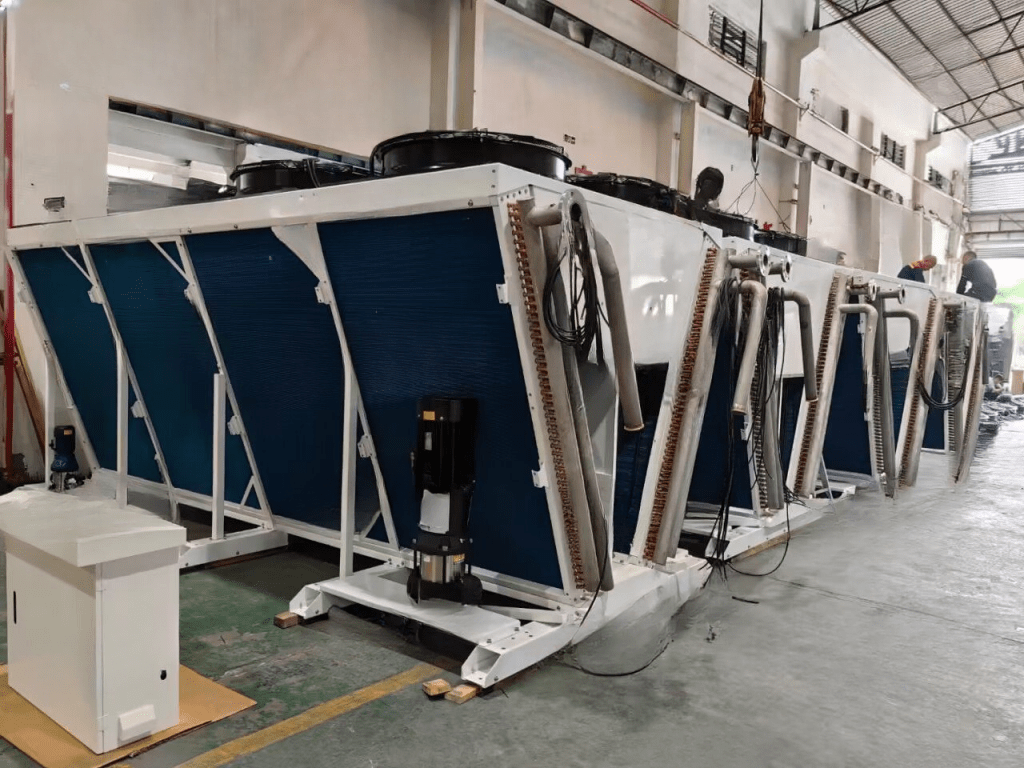V Type Dry Fluid Cooler
What is a Vertical (V-Flow) Dry Fluid Cooler?
A Vertical Dry Fluid Cooler, most commonly recognized by its V-shaped coil configuration, is a type of heat rejection equipment where ambient air is drawn vertically upward through two angled coil banks and discharged out the top of the unit by one or more fans.
The defining “V” shape is not just for looks; it’s a highly efficient design that maximizes heat transfer surface area while minimizing the unit’s footprint.
How It Works: The V-Flow Principle
- Air Intake: Ambient air enters the unit from all sides through the large openings at the base of the “V”.
- Vertical Airflow: Centrifugal or axial fans mounted at the apex (top) of the V create a powerful vacuum. This pulls the air vertically upward and uniformly through the entire surface of both finned-tube heat exchanger coils.
- Heat Transfer: The process fluid flows through the coils, and heat is transferred from the hot fluid to the cooler air moving across the fins (sensible heat transfer).
- Air Discharge: The now-warmed air is exhausted vertically out of the top of the unit.
This vertical discharge is a key advantage, as it helps prevent hot air recirculation, where exhausted warm air gets sucked back into the intakes, reducing efficiency.
Advantages of V-Flow Coolers
- Space-Saving Footprint: This is their biggest benefit. By orienting the coils at an angle in a V-shape, they pack a very large heat transfer surface area into a relatively small floor space. This makes them ideal for crowded mechanical rooms or rooftops where space is at a premium.
- Excellent Airflow and Reduced Recirculation: The vertical discharge pattern effectively throws the warm exhaust plume high into the air, away from the cold air intakes at the base. This results in more stable performance and higher efficiency, especially when units are placed near walls or other obstacles.
- Weather Resistance: The V-configuration and top-discharge design naturally shed rain and snow. It is very difficult for precipitation to enter and fill the angled coils, making them robust for outdoor installation in harsh climates.
- Suitability for Indoor Installation: Their compact footprint and efficient vertical exhaust make them easier to integrate indoors with the use of a ducted discharge plenum to direct the hot air outside.
- Uniform Air Distribution: The design promotes even airflow across the entire coil surface, preventing “hot spots” and ensuring the entire heat exchanger is used effectively.
Potential Disadvantages
- Height Requirement: The V-shape and vertical design mean the unit is taller than an equivalent horizontal airflow model. Sufficient overhead clearance is necessary for installation, transport, and maintenance.
- Maintenance Access: Fans and motors are located on top of the unit. While this protects them from weather, it can make routine inspection and servicing slightly more difficult, often requiring a ladder or overhead platform. However, many models are designed with easy-access hatches.
Common Applications
V-Flow coolers are versatile but are particularly favored in these scenarios: Data Centers: A premier application. They are used in water-side economization systems
- to cool the condenser water loop, saving enormous amounts of energy compared to using chillers year-round. Their small footprint is critical in dense data center yards.
- Industrial Processes: Cooling hydraulic oil, lubricants, induction furnaces, laser cutting machines, and plastic molding equipment where space inside a facility is limited.
- HVAC Systems: For heat rejection from water-cooled chillers, especially in urban high-rises with limited rooftop or mechanical room space.
- Power Generation: Cooling generator stator tubes, lubricating oil, and other closed-loop systems in power plants.
Comparison vs. Horizontal Airflow Coolers
| Feature | Vertical (V-Flow) Cooler | Horizontal Airflow Cooler |
| Footprint | Small (space-efficient) | Large (spread out) |
| Height Profile | Taller | Lower, wider |
| Air Discharge | Vertical (Upwards) | Horizontal (Sideways) |
| Risk of Recirculation | Lower | Higher (requires careful spacing) |
| Weather Resistance | Excellent (sheds rain/snow) | Good, but coils are more exposed |
| Best For | Space-constrained areas, rooftops, indoors with ducting | Height-constrained areas, ground-level pads with plenty of space |
In summary, the Vertical (V-Flow) Dry Fluid Cooler is an engineering solution optimized for maximizing cooling capacity per square foot of floor space. Its intelligent design addresses common issues like air recirculation and weather, making it a top choice for modern, dense industrial and commercial applications.
